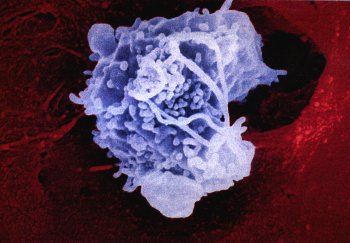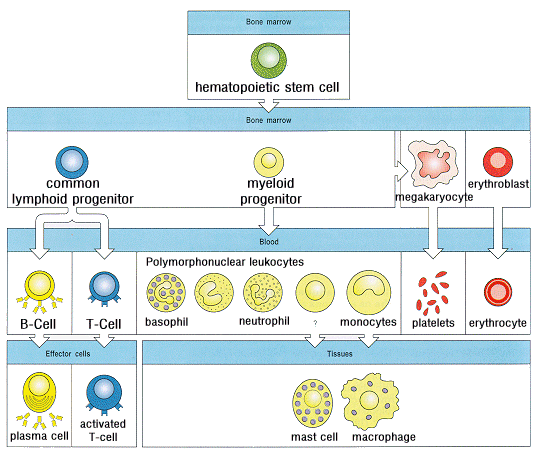


INFLAMMATORY RESPONSE
If an organism crosses the protective epidermis of the skin or the epithelia of mucous membranes of other parts of the body (ie if it gets to the subepithelial spaces) it encounters the inflammatory response which is also a nonspecific defense mechanism. Inflammation is just the body’s normal response to a infection. It is designed to keep the organisms from invading other parts of the body.
EVENTS OCCURING IN INFLAMMATION
1. Increased blood supply to affected site due to dilation of blood vessels.
2. Increased permeability of capillaries results in outpouring of numerous plasma proteins all of which fight infection.
3. Migration of leukocytes, especially polymorphonuclear leukocytes, as well as macrophages to site of infection by chemotaxis which is mediated by tissue damage.
Leukocytes and macrophages are known as phagocytic cells and are responsible for phagocytosis.
Increased accumulation of blood in area — RED.
Accumulation of fluid and cells — SWELLING
Pressure of fluid on nerve endings and release of prostaglandins — PAIN
PHAGOCYTOSIS
Phagocytic cells attache to organism and engulf the organism by encircling it within a membranous vaculoe called a PHAGOSOME. Phagosome then fuses with lysosomes to form PHAGOLYSOSOME. Lysosomes contain bags of enzymes which kill the organisms. Once phagolysosomes are formed these enzymes are released.
SPECIFIC IMMUNE RESPONSE

Not all organisms are controlled by the second line of defense. Some organisms escape the inflammatory response and enter the blood or lymph vessels beneath the epithelial layer. The blood or lymph carries these organisms to the secondary lymphoid organs and tissues throughout the body. This is where the specific phase of the immune response occurs.
SECONDARY LYMPHOID ORGANS AND TISSUES
Includes spleen, lymph nodes, tonsils, Peyer’s patches, and tissue distributed throughout the body especially at submucosal surfaces of gastrointestinal, respiratory, and genitourinary tract.
CELLS INVOLVED IN IMMUNE RESPONSE
Antigen - Presenting Cells (APCs) - Special macrophages which process and degrade the antigen and present it on their surfaces to T-helper cells.
Lymphocytes
T-helper cells - Cells which recognize the specific antigen on APCs and respond by activating whatever cell is necessary to kill the infecting microbe. T-helper cells migrate through the body.
Other Types of T cells (examples) All migrate throughout the body.
Cytotoxic T cells - Attack and lyse virus-infected cells. They migrate through the body.
Suppressor T cells - Inhibit the immune response.
Delayed hypersensitivity cells - Kill organisms like Mycobacterium tuberculosis that live in macrophages.
B cells
A type of lymphocyte that produces antibodies which are important in the destruction of extracellular organisms such as those in blood. Antibodies also neutralize bacterial toxins.
SUMMARY
The T-helper cells that are specific for the antigen on the APCs are activated and they in turn activate another type of T cell or a B cell to do something that will kill the infecting microbe. T cells are responsible for killing intracellular organisms (organisms that live within cells) and this part of the immune response is known as cell-mediated immunity. B cells are responsible for killing extracellular organisms and this part of the immune response is known as humoral immunity.
MEMORY CELLS
A specific group of B cells or a specific group of T cells that are produced each time any type of T cell or B cell responds to the antigen (foreign substance) on the APC. Memory cells remember the antigen and are able to act faster when they see the antigen again. This is why the second response to an antigen is faster than the first.
FIRST RESPONSE TO AN ANTIGEN VS SECOND RESPONSE TO AN ANTIGEN
Your body responds faster the second time it encounters an antigen because of the memory cells which "remember" the antigen and are already activated and ready to fight.

1. Give examples of the natural or native mechanisms that provide the first line of defense against invasion by pathogenic organism.
2. With regard to the inflammatory response: a) When does it occur? b) What are the events that occur and what clinical signs indicate these events are occurring? c) What is the result of phagocytosis?
3. Explain the role of each of the following cells in the immune response.
a. Antigen-presenting cells
b. T-helper cells
c. B cells
d. Cytotoxic T cells
e. Memory cells
4. Summarize step-by-step each event that occurs in the specific immune response.
5. What is the purpose of vaccination? Discuss in detail how the body responds after you are vaccinated.
6. Define the following terms:
a. Antigens
b. Antibodies
c. B Cells and Humoral immunity
d. T Cells and Cell-mediated immunity
e. Macrophage
f. Helper T Cells
g. Cytotoxic T Cells
h. Memory Cells

 Click here to go to the Archives Page!
Click here to go to the Archives Page!
 Click here to fly back to the home page!
Click here to fly back to the home page!